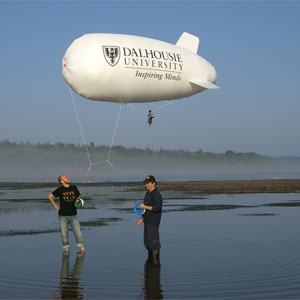 |
| Jeff Barrell and Lin Lu raise the DalBlimp on a calm morning near Eastern Passage. (Jon Grant Photo) |
When it was raised over the boardwalk at Eastern Passage at dawn, some people didnโt know what they were seeingโwas the Hindenburg really flying over McCormickโs Beach?
โOne guy said he thought it was a UFO,โ says Jeff Barrell, a PhD student in Oceanography. Together with Professor Jon Grant, he outfitted a blimp-shaped helium balloon with expensive photography equipment and sent it soaring a few hundred metres in the air.
Compared toย hiring a plane,ย the โDalBlimpโ isย a much cheaper way for researchers to acquire much-needed aerial photography of eelgrass meadows in coastal areas. ะยผำฦยม๙บฯฒสฟชฝฑึฑฒฅ four metres in length, the balloon is equipped with a global positioning system and a high-res digital camera, which is controlled by operators on the ground.
PHOTO ESSAY: The air show. (Photos by Jon Grant and Jeff Barrell)
โWe use images from planes and satellites, but itโs tricky and expensive,โ says Dr. Grant, an expert on coastal zone management. โSo I thought, โhow hard can it be to float a camera?โ Not hard at all, as it turns out.โ
After the trial run in Halifax Harbour, theyโll bring the blimp to the Acadian shore of New Brunswick where theyโre doing research in collaboration with the Department of Fisheries and Oceans.ย
Eelgrass beds are one of the best indicators of ecosystem health at the seashore. And thatโs why their depletionโby almost 90 per cent over the past century along sections of the Atlantic coastโis cause for concern.
โTheyโre like our rainforests,โ explains Dr. Grant. โIf theyโre healthy, theyโre very luxuriant and all kinds of things live there among the bright-green grasses. They provide shelter, food and even slow down water currents.โ
Eelgrass beds grow in shallow bays and coves, tidal creeks and estuaries. They serve as the habitat, nursery grounds and food for mussels, crabs, scallops, fish, birds, and numerous other species of wildlife. Up close, the long blades of grass are often covered with tiny marine creatures. But from afar, the meadows show complex growth patterns, appearing as brilliant swirls of emerald green. Growth patterns and locations are important in understanding what controls eelgrass abundance, and thus its role as a landscape feature.
Their destruction is caused by human activities, such as aquaculture and nutrient run-off from farms and fish plants, which leads to poor water quality and algae blooms which choke out other forms of growth. The loss of this habitat has possibly contributed to the decline in some fisheries populations.
โThe good news is that eelgrass beds can be restored and replanted,โ says Dr. Grant. โAnd we can make predictions about what beds are under threat and take appropriate action.โ
